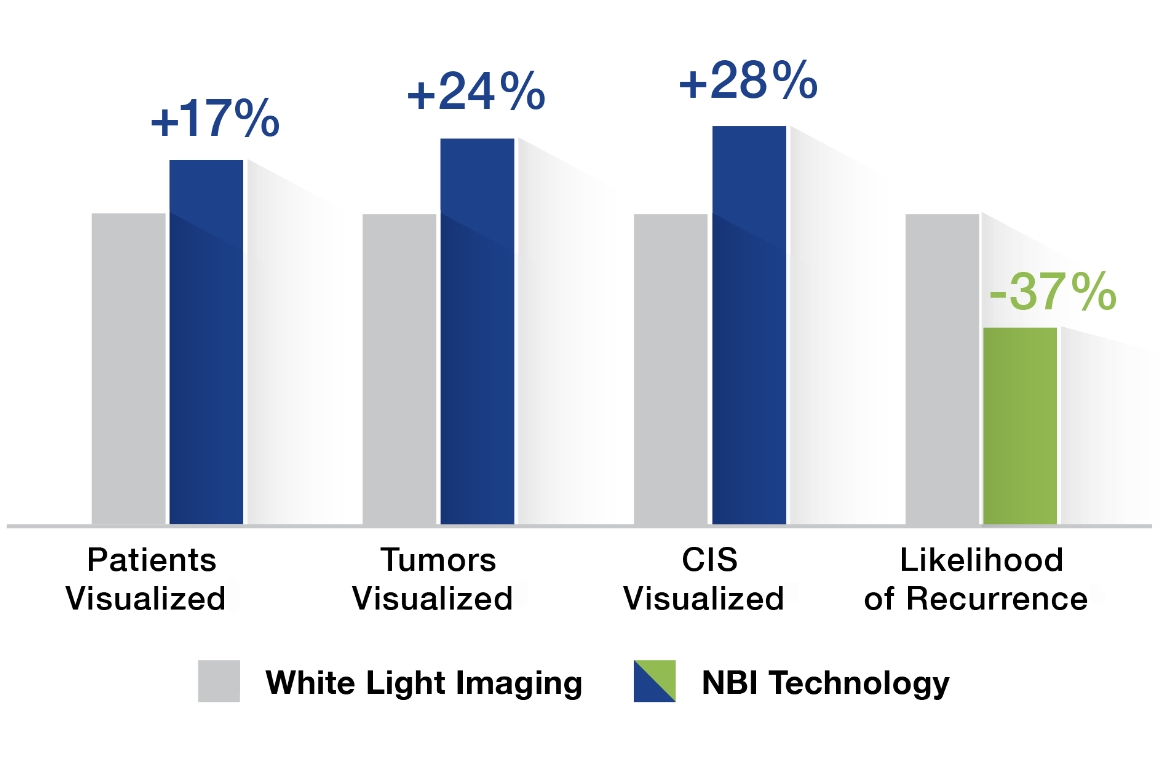Independent Meta-Analysis Shines Light on Important Visualization Modality

CENTER VALLEY, Pa., (April 24, 2024) – Olympus, a global medical technology company committed to making people's lives healthier, safer, and more fulfilling, announced today data showing that the use of Narrow Band Imaging (NBI) technology with patients with non-muscle invasive bladder cancer (NMIBC) led to 37% less likelihood of recurrence over 12-35 months.1
The data are drawn from the hazard ratio referenced in a meta-analysis, “Narrow band imaging versus white light cystoscopy alone for transurethral resection for non-muscle invasive bladder cancer,” published in 2022 in the Cochrane Database of Systematic Reviews.1
“Without dyes, without any change to the patient’s standard cystoscopy, and with only a push of a button, urologists can better visualize a lesion, and potentially contribute to reduced recurrence of what is a notoriously recurrent cancer,” said Richard Reynolds, President, Olympus Medical Systems Group. “As more urologists become aware of the benefits of NBI technology, and as more studies are published, we believe use of the modality will become the norm in an elevated standard of care.”
As reported by the American Cancer Society, bladder cancer has one of the highest recurrence rates.2 Additionally, “recurrence and progression to muscle-invasive bladder cancer (MIBC) is highly variable, depending on tumor classification and grade at diagnosis. For example, in patients diagnosed with low-grade noninvasive urothelial carcinoma (Ta), recurrence rates range from 30% to 60% at 5 years; however, the risk of progression to MIBC is ≤5%. In contrast, patients with high-grade urothelial carcinoma invading into the lamina propria (T1) have progression rates of 30% to 70%.”2
Keeping a close eye on bladder cancer is critical because of these recurrence rates, with patients typically undergoing cystoscopy every 3-6 months for years after a diagnosis.3
This recent recurrence data complements existing NBI technology claims, indicating that, in comparison to white light, NBI technology visualized NMIBC lesions in:
- 17% additional patients
- 24% additional tumors
- 28% additional Carcinoma In Situ (CIS).4
NBI is not intended to replace histopathological sampling as a means of diagnosis.
“Whether in the office or the OR setting, I find NBI technology a necessary additional evaluation component in cystoscopy for bladder cancer patients,” said Michael B. Williams, MD, MS, Associate Professor at Eastern Virginia Medical School. “Physicians should know that training to incorporate NBI technology into their practice is available and it does require some time to identify lesions effectively. However, with additional analysis showing a reduction in recurrence of NMIBC for patients whose physicians used NBI technology, there are now more reasons to adopt use of this visualization technique.”
Recent start-up activity around NBI technology and bladder cancer was recognized by Olympus in its selection of Vesica AI, a promising medical startup company, as the winner of the inaugural Olympus Asia Pacific Innovation Program (OAIP). Vesica AI was chosen from a field of four finalists for its innovative AI-based clinical visualization software that supports and enhances the early detection of bladder cancer through the cystoscopy procedure. Vesica AI is the result of a collaboration between the University of Tsukuba Hospital in Ibaraki prefecture, Japan, and the National Institute of Advanced Industrial Science and Technology (AIST), a Japanese public agency promoting scientific development. As the winning innovator, Vesica AI will receive grant funding of $75,000 as well as an exclusive mentorship program with key thought leaders from Olympus. The mentorship program will connect Vesica AI with experts from Olympus in meaningful ways that aim to support the future success of the company.
Olympus provides information, images, video and more at the NBI technology for urology product page. NBI technology will also be available for demo at the Olympus booth at the American Urological Association (AUA) conference, May 3-6, 2024, in San Antonio, TX.
# # #
About Olympus
At Olympus, we are committed to our purpose of making people’s lives healthier, safer and more fulfilling. As a global medical technology company, we partner with healthcare professionals striving to provide best-in-class solutions and services for early detection, diagnosis and minimally invasive treatment, aiming to improve patient outcomes by elevating the standard of care in targeted disease states. For more information, visit medical.olympusamerica.com.
1 Lai LY, Tafuri SM, Ginier EC, Herrel LA, Dahm P, Maisch P, Lane GI. Narrow band imaging versus white light cystoscopy alone for transurethral resection of non-muscle invasive bladder cancer. Cochrane Database Syst Rev. 2022 Apr 8;4(4):CD014887. doi: 10.1002/14651858.CD014887.pub2. PMID: 35393644; PMCID: PMC8990285.
3cancer.org/cancer/types/bladder-cancer/treating/by-stage.html
4 Li, K., Lin, T., Fan, X., Duan, Y., & Huang, J. (2013). Diagnosis of narrow-band imaging in non-muscle-invasive bladder cancer: A systematic review and meta-analysis. International Journal of Urology, 20, 602-609. http://www.ncbi.nlm.nih.gov/pubmed/23113702

